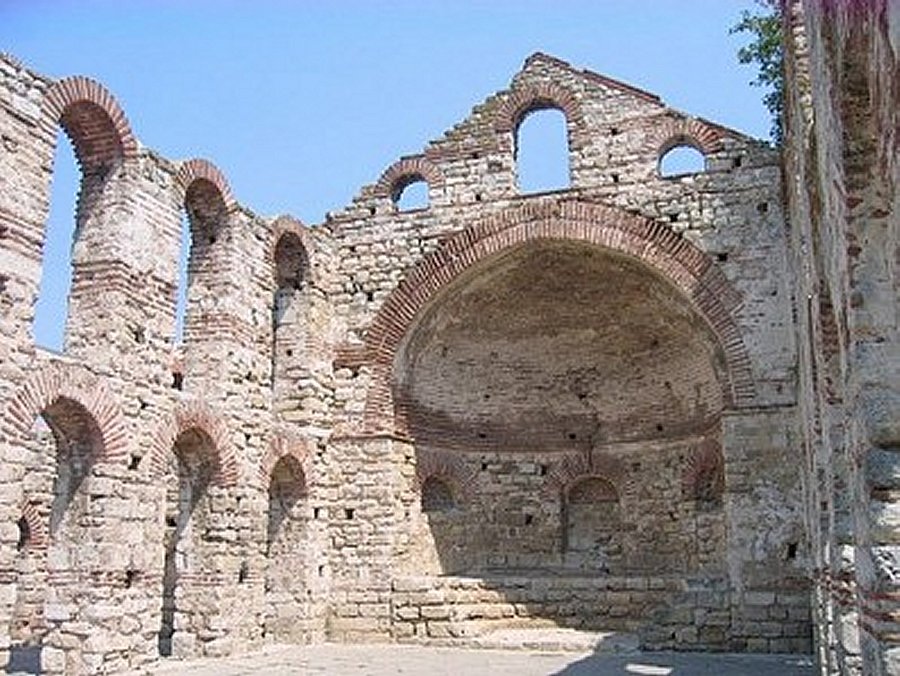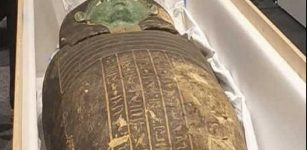Ancient Nessebar – 3,000-Year-Old History Of Many Civilizations
AncientPages.com - Ancient Nessebar, located at a peninsula in the Black Sea, has been known since ancient times.
In this more than 3,000-year-old city, many civilizations left their traces and its history is fascinating. From the beginning, Nessebar was a Thracian settlement, known as Menebria or Mesembria and founded in the 2nd millennium BC.
Archaeologists have unearthed remains of dwellings, stone anchors and a variety of pottery dated to Late Bronze Age (1500 - 1200 BC), as well as from the Early Iron Age (1200-700 BC). In addition, a fortress wall and gateway, unearthed not long ago prove that the first settlement on the Nesssebar Peninsula eventually became a Thracian city.
Greek geographer Strabo (c. 63 BC - AD 24) explains the origin of the city's name and writes as follows:
'Then [comes] Mesembria, a colony of the Megarians, formerly called Menebria (that is, `city of [Thracian king] Menas', because the name of its founder was Menas, while `bria' is the word for 'city' in the Thracian language)."
The actual meaning of the name and the memory of the legendary ruler of the seas, the Thracian king Menas (or 'Melsas'), have been preserved for centuries by the indigenous people and the Greek colonists who settled in this region and the city became a Greek colony at the beginning of the 6th century BC.
Nessebar was known as Mesembria-Mesemvria when the Christian age began and later during the Roman and Byzantine Empires. It was influenced by the culture of the ancient Aegean civilization made up of different peoples, legendary figures and memorable historical events.

The ruins of Nessebar date back to the Hellenistic period and they include a temple of Apollo,an agora and the remains of the acropolis. Photo: dnd travel
The ruins of Nessebar date back to the Hellenistic period and they include a temple of Apollo, an agora and the remains of the acropolis. Also, a wall, which formed part of the Greek fortifications, can still be seen on the north side of the peninsula.
Bronze and silver coins were minted in this flourishing city since the 5th century BC and gold coins since the 3rd century BC. It was also a thriving port in Greek and Roman times, but its importance as a port for ships sailing between Constantinople and the Danube, became obvious, first, during the Byzantine era.

Nessebar was captured and incorporated in the lands of the First Bulgarian Empire in 812 by Khan Krum after a two week siege only to be surrendered back to Byzantium.
This privilege to mint the city’s own coinage was still preserved when Nessebar fell under Roman rule in 71 BC.
We learn from ancient records that Nessebar was one of the most important strongholds of the Byzantine Empire from the 5th century AD onwards.

Nessebar was captured and incorporated in the lands of the First Bulgarian Empire in 812 by Khan Krum after a two week siege only to be surrendered back to Byzantium. Photo: https://www.flickr.com/people/24160703@N03/
Its history was very turbulent, because it was fought over by Byzantines and Bulgarians. It was passed from Byzantine to Bulgarian ownership several times throughout the Middle Ages.
In the 7th - 8th century, Nessebar was flourishing medieval city full of rich local merchants and precious works of art, fabrics, vessels and household objects.
The city was captured and incorporated in the lands of the First Bulgarian Empire in 812 by the invincible Bulgarian warlord, Tsar Khan Kroum (803-814) who conquered Nessebar (Mesemvria) in 812. This incident briefly threatened the security of the Byzantine Empire, but under the next leader the Bulgarian Tsar Ivan Alexander (1331-1371), the city began to prosper again.
Later, it was conquered by Crusaders led by Amadeus VI, Count of Savoy in 1366 and captured by the Turks in 1453, which contributed to Nessebar's decline, but still its architectural heritage miraculously remained and was even enriched.
This was very remarkable ancient city, which even in its dying days, it could still continue to thrive.
AncientPages.com
source: Pou-Nesebar-org
More From Ancient Pages
-
 Polynesian Stonehenge: Enigmatic Ha’amonga ‘a Maui Trilithon Of Tonga
Civilizations | Sep 11, 2018
Polynesian Stonehenge: Enigmatic Ha’amonga ‘a Maui Trilithon Of Tonga
Civilizations | Sep 11, 2018 -
 Number 13: Coincidence Or Bad Luck – Are We Still Superstitious?
Featured Stories | Dec 9, 2020
Number 13: Coincidence Or Bad Luck – Are We Still Superstitious?
Featured Stories | Dec 9, 2020 -
 Controversial Story And Secret Knowledge Of Li Ching-Yuen Who Lived For 256 Years
Featured Stories | Sep 19, 2015
Controversial Story And Secret Knowledge Of Li Ching-Yuen Who Lived For 256 Years
Featured Stories | Sep 19, 2015 -
 Enigmatic Ancient City Where People Experience Telepathy And Higher Level Of Consciousness
Ancient Mysteries | Oct 10, 2018
Enigmatic Ancient City Where People Experience Telepathy And Higher Level Of Consciousness
Ancient Mysteries | Oct 10, 2018 -
 Neanderthals Used Amlash Caves In Iran’s Gilan Province As Shelters
Archaeology | Aug 19, 2020
Neanderthals Used Amlash Caves In Iran’s Gilan Province As Shelters
Archaeology | Aug 19, 2020 -
 Atlit Yam – Fate Of The 9,000-Year-Old Underwater Megalithic Site With A Huge Stone Circle
Featured Stories | Jun 14, 2021
Atlit Yam – Fate Of The 9,000-Year-Old Underwater Megalithic Site With A Huge Stone Circle
Featured Stories | Jun 14, 2021 -
 2,000-Year-Old Factory Producing Roman Fish Sauce Unearthed In Ashkelon, Israel
Archaeology | Jan 7, 2020
2,000-Year-Old Factory Producing Roman Fish Sauce Unearthed In Ashkelon, Israel
Archaeology | Jan 7, 2020 -
 ‘The Waters Become Corrupt, The Air Infected’: Here’s How Ancient Greeks And Romans Grappled With Environmental Damage
Featured Stories | Nov 4, 2024
‘The Waters Become Corrupt, The Air Infected’: Here’s How Ancient Greeks And Romans Grappled With Environmental Damage
Featured Stories | Nov 4, 2024 -
 Adaptable And Flexible Neanderthals May Have Inhabited Danish Island 120,000 Years Ago
Archaeology | Oct 25, 2020
Adaptable And Flexible Neanderthals May Have Inhabited Danish Island 120,000 Years Ago
Archaeology | Oct 25, 2020 -
 Hidden Connection Between The Zodiac, Ancient Egypt, Freemasonry And Christianity
Ancient Mysteries | Aug 14, 2018
Hidden Connection Between The Zodiac, Ancient Egypt, Freemasonry And Christianity
Ancient Mysteries | Aug 14, 2018 -
 Hunter-Gatherer Genes Helped Early European Farmers Survive Disease – New Study
Archaeology | Mar 24, 2023
Hunter-Gatherer Genes Helped Early European Farmers Survive Disease – New Study
Archaeology | Mar 24, 2023 -
 5,000-Year-Old Russian Skull Offers Evidence Of Brain Surgery Made With Stone Scalpel
Archaeology | Oct 23, 2020
5,000-Year-Old Russian Skull Offers Evidence Of Brain Surgery Made With Stone Scalpel
Archaeology | Oct 23, 2020 -
 Egypt Recovers Ancient Wooden Coffin From Houston Museum In The US
Archaeology | Oct 4, 2022
Egypt Recovers Ancient Wooden Coffin From Houston Museum In The US
Archaeology | Oct 4, 2022 -
 Ancient Monastery In The Middle Of ‘Syria’s Stonehenge’ – Underground Caves, Tombs, Stone Circles Older Than Pyramids
Civilizations | Nov 13, 2015
Ancient Monastery In The Middle Of ‘Syria’s Stonehenge’ – Underground Caves, Tombs, Stone Circles Older Than Pyramids
Civilizations | Nov 13, 2015 -
 A Tooth That Rewrites History? The Discovery Challenging What We Knew About Neanderthals
DNA | Oct 23, 2023
A Tooth That Rewrites History? The Discovery Challenging What We Knew About Neanderthals
DNA | Oct 23, 2023 -
 On This Day In History: Vasco De Gama Departed On First European Voyage To India – On July 8, 1497
News | Jul 8, 2016
On This Day In History: Vasco De Gama Departed On First European Voyage To India – On July 8, 1497
News | Jul 8, 2016 -
 Chilean Mummies Clad In Red Poison Dresses – Evidence Of A Unique Inca Ritual
Archaeology | Jul 28, 2018
Chilean Mummies Clad In Red Poison Dresses – Evidence Of A Unique Inca Ritual
Archaeology | Jul 28, 2018 -
 Unexplained Mystery Of The Untraceable Stone-Throwers – Strangeness In Australia And New Zealand – Part 2
Featured Stories | Nov 13, 2019
Unexplained Mystery Of The Untraceable Stone-Throwers – Strangeness In Australia And New Zealand – Part 2
Featured Stories | Nov 13, 2019 -
 Hidden Double Message Discovered On Ancient Clay Tablet Gives A Disturbing Account Of The Great Flood
Archaeology | Dec 5, 2019
Hidden Double Message Discovered On Ancient Clay Tablet Gives A Disturbing Account Of The Great Flood
Archaeology | Dec 5, 2019 -
 The Golden Apple Myth And Norse Goddess Idun
Featured Stories | Jan 2, 2016
The Golden Apple Myth And Norse Goddess Idun
Featured Stories | Jan 2, 2016

